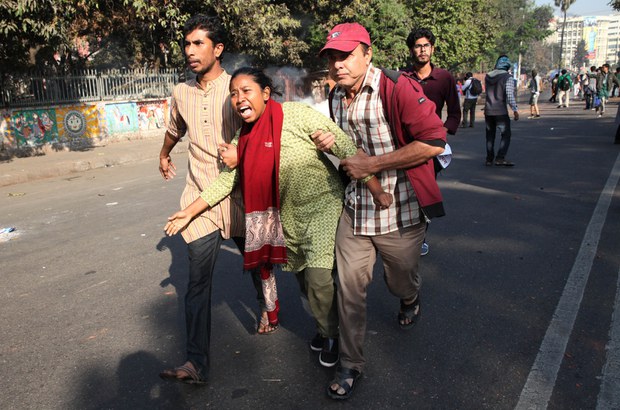Bangladesh Rejects Greenpeace Study on Power-Plant Project
2017.05.08
Dhaka and Washington
 Unidentified men grab a demonstrator as clashes erupt between police and people protesting the proposed Rampal power plant, Jan. 26, 2017, in Dhaka.
Unidentified men grab a demonstrator as clashes erupt between police and people protesting the proposed Rampal power plant, Jan. 26, 2017, in Dhaka.
Bangladesh will go ahead with building a massive coal-fired power plant despite a new report by environmental watchdog Greenpeace warning that some 6,000 people will die prematurely over a 40-year period from health problems caused by project-related pollution.
The 1,320-megawatt plant that will be constructed on the edge of the Sundarbans, the world’s largest mangrove forest, threatens to harm public health and could damage the environmentally sensitive region in southwestern Bangladesh, Greenpeace said in the report published on May 5.
Main construction on the project will begin within several weeks and is expected to be completed in the year 2020, officials said.
“We do not take the report into cognizance,” Energy Minister Nasrul Hamid told BenarNews on Monday, acknowledging he had read the Greenpeace report. “They are doing their job and we are doing our job.”
“It is not understandable how they say that over 6,000 people will meet premature deaths,” he added. “We are going ahead with the construction of the project.”
On Sunday, Hamid told members of parliament that there was “no risk of air pollution” from the coal plant, and he brushed off such concerns raised by environmental conservation groups as “propaganda.”
Bangladesh approved the coal plant as a joint venture with India, despite protests from environmental activists and experts who have warned that toxic gases released from the coal plant could destroy the Sundarbans, which the U.N. Educational, Scientific and Cultural Organization (UNESCO) listed as a World Heritage Site in 1997.
The plant will be built in Rampal, a sub-district of Bagerhat district in Bangladesh’s Khulna division.
“Even if Bangladesh currently had zero air pollution, the plant alone would cause the premature deaths of 6,000 people, and low birth weights of 24,000 babies,” Amsterdam-based Greenpeace International said in its new report.
Fragile ecosystem
The Sundarbans, named by UNESCO as a World Heritage Site in 1997, is a cluster of low-lying islands in the Bay of Bengal. It is the largest single-block mangrove forest in the world and home to hundreds of species, including the Bengal tiger and the rare Irrawaddy dolphins.
The Sundarbans covers about 10,000 square kilometers (3,900 square miles), most of which lie in Bangladesh with the remainder in India. Its dense mangroves provide a buffer against violent storms that often roar into the delta, experts say.
The Greenpeace report, prepared by coal and air pollution specialist Lauri Myllyvirta, said emissions from the plant in Rampal would increase the risk of stroke, lung cancer, heart and breathing problems in adults, as well as respiratory symptoms in children.
It said localities in the Sundarbans’ fragile ecosystem would be affected and people in Dhaka and Kolkata, India, would also be harmed by high levels of mercury, a potent neurotoxin that damages children’s brains and nervous system.
The plant is projected to discharge about 125,000 cubic meters of chemically tainted water every day into nearby water catchments, Greenpeace said.
Projected mercury releases “could be sufficient to render fish unsafe to eat over an area of approximately 70 square kilometers (44 square miles),” its report noted.
It said health and environmental impacts were assessed using four different scenarios that vary based on the levels of allowed emissions.
Greenpeace said that if the much stricter new Indian standards were followed, the predicted number of deaths would fall to 50 per year, avoiding 3,800 premature deaths over the plant’s 40-year operational lifetime.
Coal-burning
The $1.7-billion Rampal power plant involves a joint venture between the Bangladesh Power Development Board (BPDP) and India’s state-owned National Thermal Power Corp. The partnership, established in 2012, is known as the Bangladesh-India Friendship Power Co. Ltd.
The plant would be powered by almost five million tons of coal shipped annually along the fragile waterways of the Sundarbans, a natural habitat for about 450 endangered Bengal tigers and tens of thousands of spotted deer, according to experts. The United Nations warned in October that the plant would “irreversibly damage” the forest.
Greenpeace said it arrived at the projected impacts on air quality by using the CALPUFF modeling system, the U.S. Environmental Protection Agency’s preferred model for assessing long-range transport of pollutants.
It said emissions would elevate the levels of toxic particles, sulfur dioxide and nitrogen dioxide in the air over southwestern Bangladesh, with worst impacts felt up to a hundred kilometers to the northeast.
“These emissions would make the Rampal power plant one of the largest point sources of air pollution in Bangladesh,” the report said, adding that millions living in Bangladesh and as far as neighboring India would potentially be affected.
Bangladesh currently has a power-generation capacity of about 12,000 megawatts, but the BPDP has estimated that demand would almost triple within 13 years and expects that about 15,000 megawatts of the demand will be supplied by coal-fired plants.







